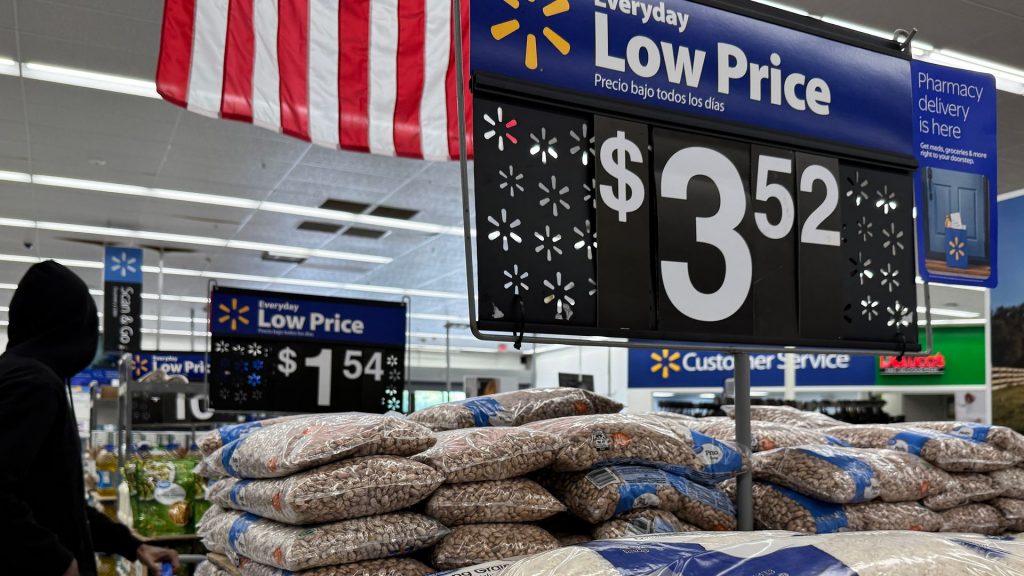Where Walmart is ‘the only game in town,’ a bellwether for Trump’s tariffs
Ella Greene April 18, 2025 0
- Walmart Inc. has thousands of stores across the U.S. and is highly dependent on imports for its business. Needing imports from particularly China raises a question: How will the business respond to President Donald Trump’s tariffs?
- Walmart dominates many local markets, and P.J. Bryant lives in a small town in New Mexico, where the superstore is “basically the only game in town.”
- While Walmart has been slowly moving away from Chinese imports, from 80% of products in 2018 to 60% of products in 2023, Walmart is likely to still be sensitive to increased tariffs.
Full Story
Walmart is America’s largest retailer — and one of its biggest importers. Much of the clothing, electronics and other goods for sale at the company’s 5,205 U.S. stores come from overseas, a majority from a single source: China.
That makes Walmart a bellwether for the effects of the significant tariffs President Donald Trump has imposed on goods from China, as well as the levies temporarily suspended for imports from other U.S. trading partners.
If tariffs drive prices up at Walmart, the impact will be felt by consumers across America — especially the millions for whom Walmart is practically the only place to shop.
Walmart accounts for at least half of all retail grocery sales in 43 metro areas and 160 other smaller markets, according to a study by the Institute for Local Self-Reliance. In two cities — Atchison, Kansas, and Portales, New Mexico — Walmart has a 95% market share. In 15 others, it captures at least three-fourths of all grocery sales.
Beyond the financial impact on consumers, how Walmart responds to the tariffs also could heavily influence public opinion about Trump’s economic policies, including in areas where he has run strongly in the past three presidential elections.
Shopping when Walmart is ‘the only game in town’
P.J. Bryant is a 34-year-old single mother who lives on the outskirts of Cliff, New Mexico, population 132, and a rugged 35-mile drive to the nearest Walmart Supercenter in Silver City. Bryant, the marketing manager for a local telephone and internet provider, describes herself as “a small-town kid in an adult body” who loves living in a place where she can barely see her closest neighbor’s house.
“It’s just much more homey to me than anywhere, like being in a city or a town,” Bryant said.
But when she needs to shop, “Walmart’s basically the only game in town,” whether that’s for groceries, clothing or other items.
“They’ve created that dependence on them,” she said, “because there are no other options.”
So, Bryant and others who live in places like rural New Mexico are sensitive to price increases at Walmart. With high tariffs in place, she’s paying close attention.
“I want to compare it to, you know, what’s getting more expensive,” she said. “Where are we going to feel it the most? … And then, for savings purposes, moving down the road so that, you know, we’ll be able to see, ‘Well, OK, this is something we’re going to have to cut out.’”
How much does Walmart import from China?
Walmart doesn’t disclose exactly how much it imports, or from where. The company told investors earlier this month that about two-thirds of its merchandise comes from the United States, including much of its grocery inventory.
However, a Reuters analysis in 2023 concluded that 60% of Walmart’s imports came from China, down from 80% five years earlier.
Walmart reportedly diversified its sources of merchandise during the first Trump administration, fearing that aggressive tariffs would drive up the cost of Chinese-made goods. The company began sourcing larger shares of products from other Asian countries, notably India and Vietnam.
Still, China supplies most electronics, clothes and toys sold at Walmart, Reuters reported recently.
Walmart began preparing for new tariffs as Trump took office earlier this year, reportedly by pressuring its Chinese suppliers to cut prices by 10% for each round of new U.S. levies. According to The Wall Street Journal, Chinese officials met with Walmart executives in March, arguing that the demand for concessions was unfair. Walmart persisted, however, leveraging its enormous purchasing power to seek lower prices.
It is not alone in asking Chinese suppliers to absorb at least some of the cost of Trump’s tariffs. Target and Costco have reportedly made similar efforts.
What does Walmart say about prices?
Amid uncertainty over the tariffs, Walmart withdrew its profit projection for the first quarter of 2025, after initially telling investors it expected earnings of 0.5% to 2%. It is expected to report first-quarter earnings on May 15.
What’s unclear is whether the company will absorb the cost of the tariffs or pass them on to its consumers, who are accustomed to finding an array of goods at what Walmart calls “everyday low prices.”
In public, at least, Walmart is keeping its options open.
A recent statement by the company said it still has “the desire to maintain flexibility to invest in price as tariffs are implemented.”
At an investors’ conference on April 9, Walmart CEO Doug McMillon said: “We’re going to do our best to keep prices as low as we can.”
That could mean the company will swallow all of the cost increases — or share the burden with customers.
“Two-thirds of what we sell in the U.S. is made, grown or assembled here,” McMillon said. “There could be embedded costs over time that go up on that portion, as well as the other third. … We have, over the years, adjusted country of origin on some things, and we will manage that mix artfully.”
But John David Rainey, Walmart’s chief financial officer, said that while the company’s imports come from all over the world, “China and Mexico are the most significant.”
President Donald Trump has imposed a 145% tariff on Chinese goods, and Mexico is among the countries threatened with additional tariffs by this summer.
How will shoppers, and voters, react?
Just like the executives who run Walmart, P.J. Bryant is uncertain about how Trump’s tariffs will play out.
Bryant voted for Trump last year but, as she put it, probably wouldn’t invite him for Easter dinner, saying, “I don’t like the guy.” But she said she thought the country needed the change Trump promised.
“Life was getting hard for everybody and everyone around us,” she said.
Now, she’s both worried and optimistic.
“I can see in the grand scheme of things — like, in theory — where he thinks this is going to go,” Bryant said. “Although, I can also see the downsides of where it’s going to go for us in the short term. And for an already financially strained population, I can see that this is going to be tough and hard to accept.
“He said it himself that it’s going to get worse before it gets better,” she said. “I’m just hoping it gets better quicker than it looks right now.
“If prices go up the way some people are projecting, I don’t think we can sustain for four years that way.”
Related Stories
Ella Rae Greene, Editor In Chief
Ella Greene
Ella and the staff at Clear Media Project (CMP) curate these articles.
Unless otherwise noted CMP does not write these articles.
The views, thoughts, and opinions expressed in the articles published on this blog belong solely to the original authors and do not necessarily reflect the views of the blog owner. The blog owner does not claim ownership of the content shared by contributors and is not responsible for any inaccuracies, errors, or omissions.
All rights and credits goes to its rightful owners. No Copyright Infringement is intended. If you believe any content infringes on your rights, please contact us for review and potential removal.





